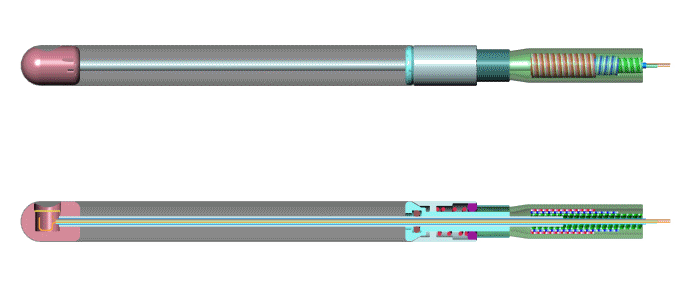 Publications | Education | Experience | Electronic Media | Portfolio | Patents | Links
Publications | Education | Experience | Electronic Media | Portfolio | Patents | Links
Miniature Probe
CAD Model created
in Solidworks
Animation created in Jasc Animation Shop
This is a device that
was invented by Fred Silverstein and Andrew Proctor
United States Patent 5,178,150
 An endoscope is a device
placed down your throat, used to examine your digestive system
An endoscope is a device
placed down your throat, used to examine your digestive system
(esophogas, intestines, or stomach). It uses fiber-optics to
send light down and additional fiber-optics to return an image
to the doctor. During an
exam, if they see an abnormality, they may want to examine what
is under the
tissue. Fiber-optics can't do this, but ultrasound can. The endoscopes
have
another tube in them, called a biopsy channel. They can use this
tube to send down an
instrument to cut out tissue to be tested, or they can send down
a small
ultrasound device such as this one to do further examination before
taking tissue.
The biggest problem
is that to do an ultrasound, you need to have space
between the transducer (that's the part of the probe that actually
does the
scanning) and what you are trying to scan - this is called acoustic
standoff. Since the tube
is so narrow, you can't send something down that would be big
enough to
provide this standoff. The idea of this device is that the balloon
around the transducer is filled with fluid. It passes down the
endoscope's
biopsy channel in the stretched out state. Then, once it's inside
and ready to scan, part
of it is pushed forward, forcing the balloon to "blow up".
Now, there's space around
the transducer, and the transducer can scan the area. When they're
ready to remove it,
they pull it back so it's in the enlonged state, and bring it
back out.
We
made a C.A.D. model of the device and this animation
for marketing purposes for Washington Research Foundation


